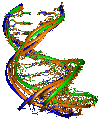Discrete Surface Charge Optimization
DiSCO - A package to represent a macromolecule as a geometric model with optimized discrete charges on its surface. It can reduce much of the electrostatic force and energy calculation in the molecular dynamics, especially for the systems that are too large to be studied on the atomic level (see applications). DiSCO was pioneered by Daniel A. Beard [1] and developed by Qing Zhang [2] in the laboratory of Prof. Tamar Schlick. Three main steps are involved in DiSCO:
- Calculate the electrostatic potential of the macromolecule by solving the nonlinear Poisson-Boltzmann equation (PBE) with QNIFFT (Sharp and coworkers) [3]. (QNIFFT is an outgrowth of DelPhi (Honig and coworkers) [4].)
- Build a smooth model surface based on the geometry of the macromolecule, and assigns a few hundred discrete Debye-Hückel (DH) charges on the model surface. (The dielectric constants inside and outside the model surface have a same value as that of the solvent.)
- Minimize the residual of the electric field between the nonlinear PBE solution and the DH approximation by optimizing the discrete surface charges with TNPACK (Schlick and coworkers) [5-7]. (TNPACK is already included in DiSCO.)
- System requirement: SGI IRIX IP22 or higher (type "hinv" to check)
- Program requirement: QNIFFT (Sharp and coworkers)
- Download DiSCO-1.2.tar (164 kb, executable)
- Beard, D. A, & Schlick, T., Modeling salt-mediated electrostatics of macromolecules: The Discrete Surface Charge Optimization algorithm and its application to the nucleosome. Biopolymers, 58: 106-115, 2001.
- Zhang, Q., Beard, D. A., & Schlick, T., Constructing irregular surfaces to enclose macromolecular complexes for mesoscale modeling using the Discrete Surface Charge Optimization (DiSCO) Algorithm. J. Comput. Chem., 24: 2063-2074, 2003.
- Sharp, K. & Honig, B., Electrostatic Interactions in Macromolecules: Theory and Applications. Ann. Rev. Biophys. Chem., 19: 301-332, 1990.
- Honig, B. & Nicholls, A., Classical electrostatics in biology and chemistry. Science, 268: 1144-1149, 1995.
- Schlick, T. & Fogelson, A., TNPACK - A truncated Newton minimization package for large-scale problems: I. Algorithms and usage. ACM Trans. Math. Softw., 18: 46-70, 1992.
- Schlick, T. & Fogelson, A., TNPACK - A truncated Newton minimization package for large-scale problems: II. Implementation examples. ACM Trans. Math. Softw., 18: 71-111, 1992.
- Xie, D. & Schlick, T., Remark on algorithm 702 - The updated truncated Newton minimization package. ACM Trans. Math. Softw., 25: 108-122, 1999.
ACKNOWLEDGMENTS
We thank Dr. Barry Honig and co-workers for providing the GRASP program, and Dr. Kim Sharp and coworkers for developing the DelPhi program QNIFFT. We also appreciate discussions about TNPACK with Dr. Dexuan Xie, discussions about AMBER force field with Dr. Xiaoliang Qian, help from Dr. Daniel Strahs, and communications with Dr. Jing Huang. Support by the National Institutes of Health (R01 GM55164) is gratefully acknowledged.
